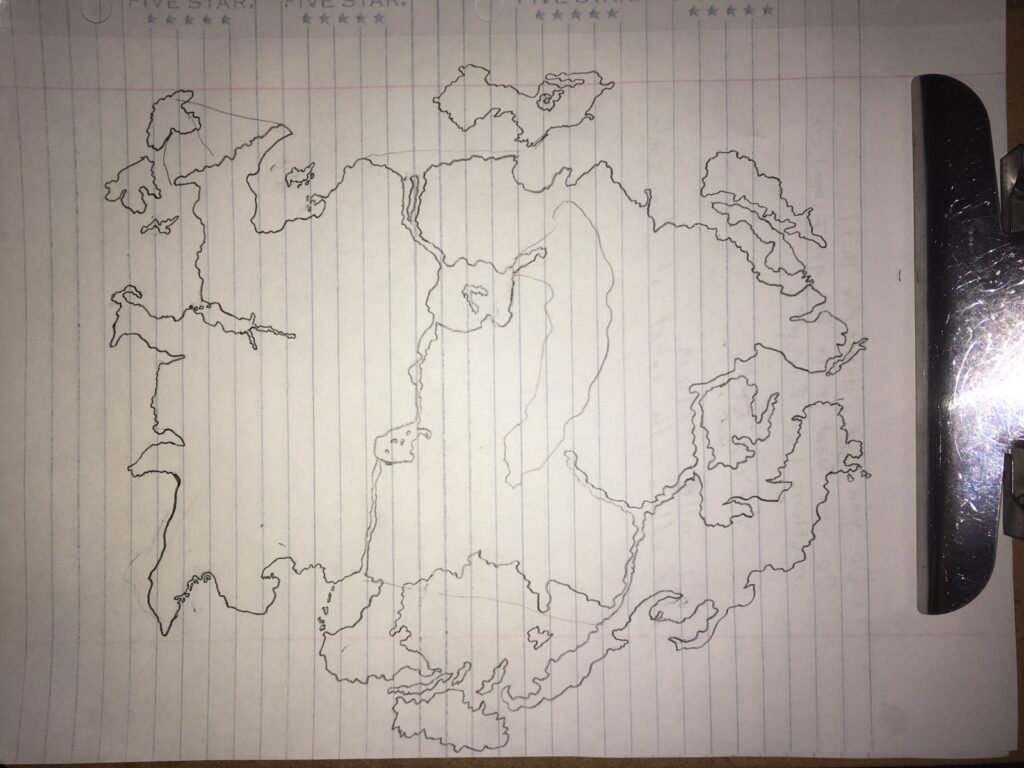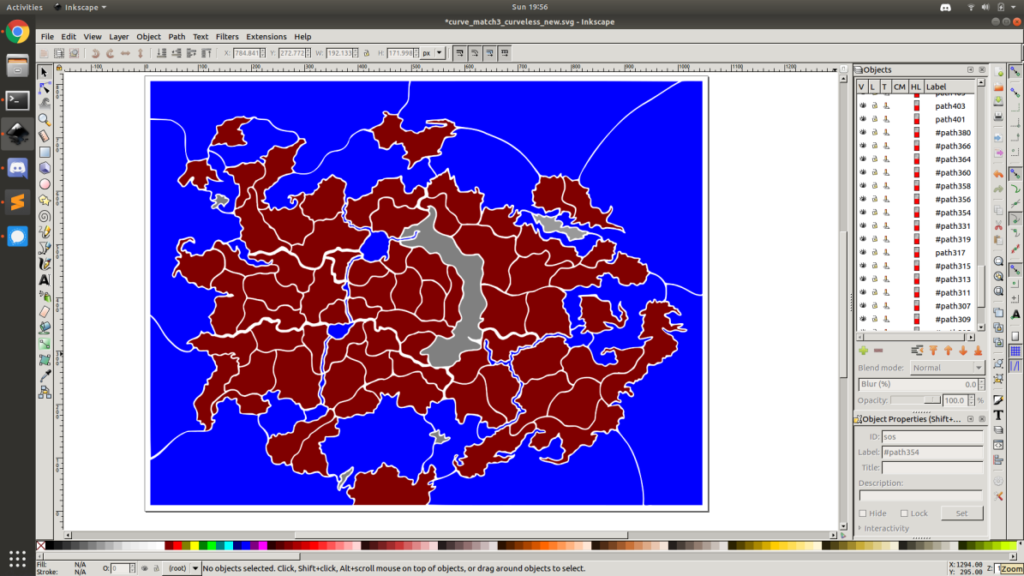Enterin is the smallest of three continents on the planet of Vester. It is slightly larger than Europe but detached from the other two continents rather than acting as one massive peninsula. Its western shores are generally cooler with storms rolling in from the northwest bringing rain and snow depending on the season. This is the location of the now ruined Enterin Empire and its numerous successor states. The Empire once stretched from the northern to southern shores and even today its legacy still dominates the intellectual and cultural history of the continent. This is most evident in their vain decision to name their home continent after their own empire, but also present in the subtleties of the law present in each of its successors.
The center of the continent is covered in tall mountain ranges that prevent easy travel between the east and the west unless you travel along the coast or by sea. Today the mountains are referred to as the Barrier Mountains, but they have also been known as Enterin’s Crown, God’s perch, the Divide, and most commonly as “those big mountains.” Stemming from somewhere in the Barrier Mountains and stretching all the way to the south is the Verna river, named after the Celestial goddess of travel. The Verna is often very wide and moves extremely fast in some areas. Midway through its journey it meets with the Vindus tributary, which also begins in the mountains, but flows westward instead of southward. Vindus is the Celestial goddess of the sky and is often depicted as Verna’s wife. The river is a focal point for most civilizations on the western side of Enterin, there is strong archeological evidence of attempts to alter its flow to some of the first nations who attempted to settle there.
To the east of these mountains lies the massive Corlan Desert, thanks to the Barrier’s rain shadow. Animal life in these deserts is much different due to the fact that they gain energy through magic as opposed to food and water. As you venture to the southern edge of the desert you begin to enter the Veil, an area of lowlands that is prone to flooding. This leaves behind a large marsh area along with a dense fog that constantly obscures the land. The desert and the Veil are the home of the nine Corlus nations. A wide variety of peoples that trace their origins to a coalition against the Enterin Empire a millennia and a half ago. Each nation has their own origin from slave revolts to the original inhabitants standing in opposition to invaders, these groups now live across the east in nomadic or semi-nomadic clans. Those that live in the desert have built large cities on the back of massive quadrupedal colossi made of stone. These colossi move across the desert and are focal points for magic that conjures water for life to grow upon its back.
Further east, past the Veil and the desert are several countries that have access to large river beds and possibly access to trade routes with the other two continents. Though, this third of Enterin has not been finished yet.
For a more visual presentation of Enterin, scroll down to see various maps made by various friends.
Human history on Enterin began around ten thousand years before the events of the time period I usually write about when humans migrated from the other two continents and landed on the southern and northwestern shores at around the same time. These initial founders would discover a cooler climate compared to the other continents of Vester, along with strange mythical powers unlike those that were from their old homes which sparked the creation of several new religions. Time would progress up to the iron age seeing the rise and fall of several kingdoms and empires. Around seven thousand years later, sorcerers who took residency in the Barrier Mountains claimed to have visions of an eternal empire that would transcend the confines of time and space. With their vision in mind they rallied an army and founded the Enterin empire in present day Marin, a massive city on the Verna river, a few miles north of the Vindus tributary. From there, the empire spent the next half millenia expanding across the western half of the continent. When it could not fully control a region, it often set up a puppet kingdom to rule in their stead, the most famous of these is the northernmost Kingdom of Sovare.
In those days, magic was not as common and required an inherent trait that allowed one to channel power directly through their body. The emperors of Enterin were strict in finding each of these gifted individuals and indoctrinating them into the nobility or the army as soon as possible. Outside of the Empire, people had begun to experiment with magic since before their arrival on the continent, discovering that anyone could harness magic if they were able to find some material that could channel it. Unfortunately, these materials were exceedingly rare and could often only be found in small meteor fragments that fell from space, preventing advancements in spellcasting that are common in the present.
The Empire’s religion was one based off of worshiping the Emperors as gods sent from heaven to guide humanity into the future. Those who fought for the gods’ holy mission would be guaranteed a place in paradise for their struggle. Faith was enforced by the Emperor’s Council, a group of eight spiritual and governmental officials who were personally appointed by the ruling Emperor. It is worth noting that reference to the Council vanished towards the later half of the Empire, indicating that their power was either diminished or that the institution was dismantled due to political reasons.
Eventually, the Enterins began to grow greedy and attempted to continue their expansion into eastern Enterin and across the sea. The only reason why this was even possible was due to the massive bureaucracy that kept track of the taxation and distribution of resources, and the cheap slave labor that helped grow food and manufacture the weapons needed for the army. But as the army was stretched thin and faced massive setbacks on multiple fronts, the cracks in the empire began to manifest. Slave revolts began to breakout across the southern half of the empire. Matters were made worse when Emperor Theus died and his two daughters, Malin and Marin both laid claim to the Empire, fracturing the Empire’s forces and their already overwhelmed administration. In many ways, the fall of the Empire was inevitable at this point, but any arguments that it could be saved completely vanished after the Stellar Intervention.
The Stellar Intervention marks a year of horrible natural disasters and destructive wars across the continent and marks the beginning of all modern calendars. Every religion on Enterin, and to some extent on the entire world, makes reference to this time period. Most sources note this time period as “the year the gods walked amongst mortals.” It is clear to see why this was the case, Vester was once a planet with two moons, one that was about the size of Earth’s moon and another that was much much smaller. During the Stellar Intervention, the smaller moon deorbited and spun into the planet. It is said that the gods themselves stepped in to prevent the total destruction of the world, though the land now bears permanent scars that relate back to this time. This smaller moon still exists in the sky in a way, in the form of a large ring that surrounds the planet along its equator.
While the exact cause of the moon’s destruction is the cause for debate, its effects skyrocketed the number of magic users across the planet. The first reason was due to the moon’s debris scattering across the world, providing foundations for astronomical magic and all successive forms of magic. The second reason is that the air in the world was saturated with dust and debris from the moon, giving everyone breathing organism a latent capacity for magic. For the Empire, this meant that they no longer held a monopoly on magic users
Within three decades, the Empire collapsed in on itself, but where many feared a dark age would begin, a new era of regrowth sprouted. Over the two centuries after the Empire’s destruction, the Seven Successor Kingdoms formed from the remnants. Starting from the north and moving southward, these kingdoms were Sovare, which had endured the destruction of the Intervention, Parsé, the Calum Dynasties, the city state of Marin, Reyvase, Atrila, and Vernlin.
An important note is that while these seven kingdoms are lumped under the same category, they did not necessarily exist simultaneously. It is from these seven kingdoms that the modern day states gradually arose from. Many of these regions developed their own religions to replace the ruined Enterin system and incorporate the new inspirations taken from the Intervention.
This sets the stage for the next century and a half of Enterin’s history. The world has been devastated by the Stellar Intervention and the continent is recovering from the destruction caused by the Enterin empire. Where there were once twin moons, there is now only one, and a great ring now rests in the southern skies. Across the different kingdoms, people begin to hear the distant whispers of gods, both young and old. Magic was now widespread across the population and it had become abundantly clear that a new age had dawned upon the world.



Next week, expect the continuation of the Celestial myths with the story of Hiporus, the first doctor. In two weeks, we’ll dive into the basics of magic and how it lead to the creation of the Kingdom of Estrelin.
Be First to Comment